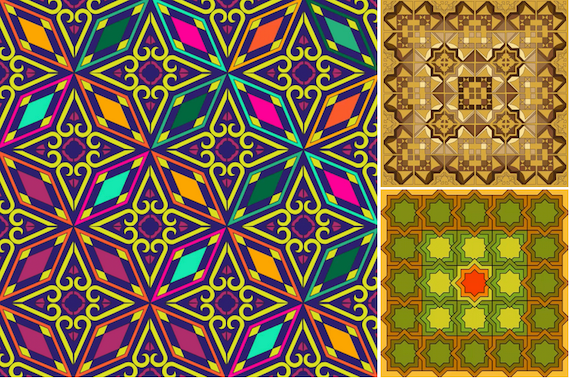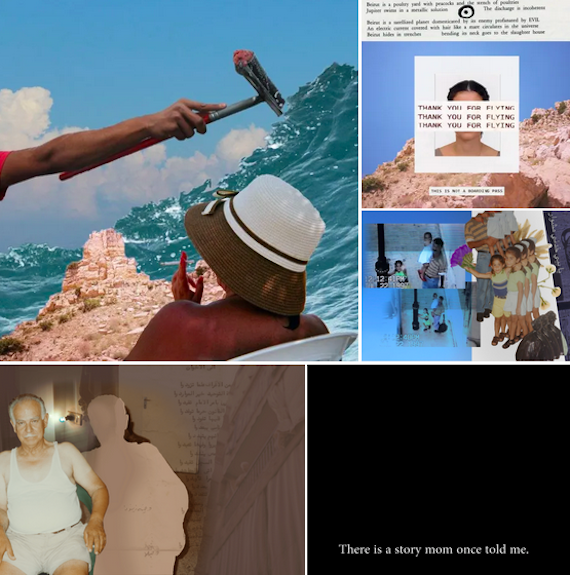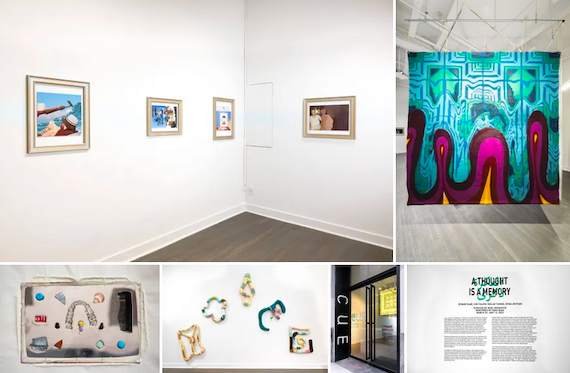![Works by Zeinab Saab as part of A thought is a memory, curated by Noel Maghathe. Presented by CUE Art Foundation, 2023 [Photo by Filip Wolak]](https://i0.wp.com/www.middleeastmonitor.com/wp-content/uploads/2023/04/My-project-1-5.jpg?resize=1200%2C800&quality=85&strip=all&zoom=1&ssl=1)
A collective show at CUE Art Foundation in New York reflects on the hybrid identities of Arab Americans. Called “A thought is a memory”, the show is curated by Noel Maghathe and runs until 13 May. The curator believes that a central issue for Arab-Americans is whether or not those who are either born in or migrated to the US are creating new narratives for themselves. And are they ever holding onto false memories?
The group show explores this issue and brings together work by four artists: Zeinab Saab, Kiki Salem, Nailah Taman and Zeina Zeitoun, all of whom have lineages going back to the Arab world and draw upon their varied backgrounds.
Through sculpture, photography, collage, animation and painting, the artists look at what happens when memories are disrupted by displacement, migration and political upheaval. They present works that reimagine their cultural hybridity as Arab Americans, layering experiences that are personal, familial, communal and political.
![Installation view of A thought is a memory, curated by Noel Maghathe. Presented by CUE Art Foundation, 2023 [Photo by Filip Wolak]](https://i0.wp.com/www.middleeastmonitor.com/wp-content/uploads/2023/04/03.-Installation-view-of-A-thought-is-a-memory-curated-by-Noel-Maghathe.-Presented-by-CUE-Art-Foundation-2023.-Photo-by-Filip-Wolak.jpg?resize=500%2C333&quality=85&strip=all&zoom=1&ssl=1)
Installation view of A thought is a memory, curated by Noel Maghathe. Presented by CUE Art Foundation, 2023 [Photo by Filip Wolak]
Maghathe — who goes by the pronouns “they/them” — feels that the conversation around the identity of Arab Americans has definitely evolved in recent years, both globally and within the art world. “We are seeing more diverse and nuanced representations of Arab identity in art, literature, and popular culture within the mainstream media,” they told me, highlighting the importance of having this show at this moment in time to create a platform for dialogue.
“I view this exhibition as resistance in some form,” said Maghathe. “I believe that highlighting Arab creatives in all aspects of this exhibition challenges the dominant narratives around Arab identity in the United States.”
“If I didn’t remember that I am, I won’t be”
“As a Palestinian American, my personal relationship with the memories of my ancestors has been complex,” they explain after tackling Arab heritage for the second time, following last year’s show at Wave Pool Art Centre called “Amid”, which centred on queer and women Palestinian artistic practices.
“I see celebrating and subverting inherited identities as recognising the complexities and contradictions of our cultural heritage, pointing out that art is a means of exploring and redefining those identities,” added the curator, who was inspired by a quote from late Lebanese-American artist and poet Etel Adnan for the show’s title: “If I didn’t remember that I am, I won’t be. Reason and memory move together.”
![Installation view of A thought is a memory by Noel Maghathe. Presented by CUE Art Foundation, 2023 [Photo by Filip Wolak]](https://i0.wp.com/www.middleeastmonitor.com/wp-content/uploads/2023/04/24.-Installation-view-of-A-thought-is-a-memory-by-Noel-Maghathe.-Presented-by-CUE-Art-Foundation-2023.-Photo-by-Filip-Wolak.jpg?resize=500%2C333&quality=85&strip=all&zoom=1&ssl=1)
Installation view of A thought is a memory by Noel Maghathe. Presented by CUE Art Foundation, 2023 [Photo by Filip Wolak]
As both an artist and a curator, Maghathe thinks about the creation of exhibitions through multiple lenses, and this helps them to connect with artists. “I frequently communicate with the artists to get approval and make sure everyone was brought along in the process of displaying their work. Maybe this is because I am also an artist, so I understand the process on both sides.”
The selection of artworks by the curator was centred around formal aspects, such as the unconventional use of colour, as well as thematic, like the reflections of moments of memory within the works. In addition to that, celebrated curator Sara Raza was a mentor for the show, guiding and giving her input to the project.
Kiki Salem: Traditional patterns and embroidery
Artist Kiki Salem is exhibiting three animations and two paintings at the show. The reverse side of the two projection screens – which showcase animations — have paintings of similar repeat patterns that appear to be melting.
The artist began working with this style this year, after spending three months in Palestine last summer. On that trip, she visited the last tile factory in Nablus and the last Keffiyeh factory in Al-Khalil (Hebron). “My work is an attempt to honour, preserve and refresh the traditions that make our daily culture unique to our region,” she explained.
Tradition is an interest that Salem has deepened, as she already felt like she inherited her affinity for traditional textiles from both her grandmothers, one Palestinian, one Brazilian, both of whom were dressmakers. “I believe I’m the last in my bloodline to do the kind of work that was part of women’s daily life before my time. My Palestinian grandmother Fatima was a master embroiderer of Palestinian Tatreez (an embroidery style that is uniquely Palestinian).”
The artist said that her grandmother spent the majority of her life developing Tatreez patterns that were sought after across Palestine. Salem studied her work, and while she recreated her patterns, she felt very connected to her. “I admire her greatly. With her work, she provided for her children after my grandfather died.”

Zeina Zeitoun: displacement, migration, trauma
The work that Zeina Zeitoun is exhibiting consists of four digital collages and one short film, based on her ever-growing collection of family videos and photos, poems and songs, as well as miscellaneous items collected during trips to Lebanon. These items were deconstructed to create an exact memory, or a new one that never existed. The collages are paired with a short film that was made in 2017 called “Happiness is the Sea” and “My Baba Smiling”.
“The latter explores my father’s hidden past from my hazy perspective and the Lebanon he left behind,” she told me. “Displacement, migration and trauma heavily alter the way we remember, and what we remember, and I’m certain that was the case for our ancestors. I have related to those generational memories, or lack thereof, in a way that feels lonely and soul-searching. How can we know our history and who we are if our displacement and migration have forced us to forget who we are for centuries?”
Zeitoun thinks that it’s extremely important to celebrate the identities we inherited, but at the same time take into account that these wouldn’t be where they are now if it weren’t for the inevitable subversion that comes with migration, displacement, trauma and time simply moving forward.

Nailah Taman: ancestral collaboration
Nailah Taman has three cloth pieces in the show. “Taeta’s Tabletent” connects to the themes of the show for its nature tied to ancestral collaboration and reworking of memories to incorporate generational needs and nourishments, without being revisionist about the past.
“By adding objects encountered in my life, from things picked up on routes I take to the blanket from my bed patched into the table tent, I add my own memories and energies to the textile. I preserve bits of myself in resin that serves as windows to look through that have a natural distortion and perspective.”
Etel’s Sigils are sculptural excerpts from Etel Adnan’s “The Arab Apocalypse”. Their forms are taken from the poetry, and anthropomorphised into bright and unworldly forms. In Plushieglyphs 1-5, a series of hand-sewn soft sculptures, the artist draws influence from petroglyphs and hieroglyphs to create “plushieglyphs”.
“This is my interpretation of a new symbolic language rooted in comfort and softness. Utilising symbols is a use of language and art that helps another, more desirable world,” said Taman. “The study of archetypal images, symbols, and sigils delimits us from contemporary identity representation and returns us to the ancestral influences and tools we need to rebuild the New Unsettled World.”

Zeinab Saab: childhood nostalgia
In her work at the show Zeinab Saab focuses on the grid, colour theory and childhood nostalgia. “It’s a nostalgia towards something I wanted but never had. Colours are intentionally bold and inspired by childhood art materials such as gel pens and Lisa Frank art products. I intended to mix childlike joy with formal artistic elements of design within a grid.”
Rather than tapping into ancestry, the work taps into the artist’s younger self and allows that being to come to the foreground.
Saab believes that Arab Americans don’t have to hold on to the identities that they have inherited, nor do they have to work on things that make their identity the focal point. “The Islamic/Arab lineage is not overtly present in my work, but the grid, constant measuring, and precision is the language that binds me to the past. I am just translating it in a different time and place. The work for me is not as much a celebration of the inherited identities; rather it’s a subtle challenge of it.”

The Evolution of the Arab American identity
Zeinab Saab thinks that we still live in a culture that is Islamophobic and yet at the same time she sees different generations of Arab Americans showing a great deal of complexity and nuance to the identity within different generations. “In all honestly, the art coming from the Arab American diaspora excites me because it too does not want to fall into the trap of repeating the same motifs of who we are. They are investigating it, opening it, breaking it, and rebuilding Arab identity on foreign land with new communities they engage with every day, whether in person or virtually.”
With the rise of the internet, Nailah Taman has witnessed an evolution in the discourse on Arab identities, which also translates into the ability to connect with other South-West Asian and North African (SWANA) artists from around the world and within the US. “I’ve met artist friends and collaborators through Instagram who have become lifelong community members.”
For Zeina Zeitoun, the conversation around the identity of Arab Americans has definitely evolved in the art world, and is moving slowly outside to the wider society. Kiki Salem added the observation that Arab art and architectural design have always been appropriated, with very little credit given to the ancient cultures that developed them. “That being said, I’m excited about the future of Arab art and I want to be a part of this wave.”

Installation view of A thought is a memory, curated by Noel Maghathe. Presented by CUE Art Foundation, 2023. Photo by Filip Wolak.”
The views expressed in this article belong to the author and do not necessarily reflect the editorial policy of Middle East Monitor or Informed Comment.
 This work by Middle East Monitor is licensed under a Creative Commons Attribution-NonCommercial-ShareAlike 4.0 International License.
This work by Middle East Monitor is licensed under a Creative Commons Attribution-NonCommercial-ShareAlike 4.0 International License.

 © 2025 All Rights Reserved
© 2025 All Rights Reserved